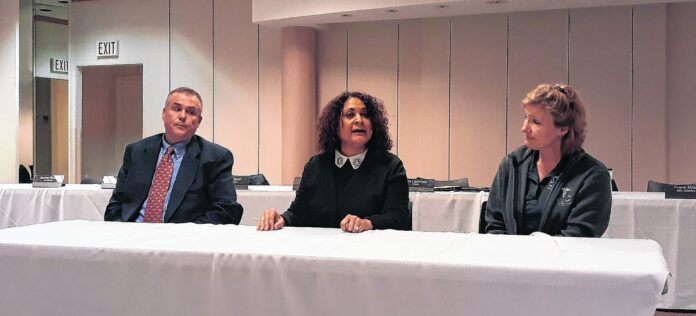
A drug treatment program for Bartholomew County Jail inmates has started months ahead of schedule, with 12 female inmates and six male inmates already receiving treatment for substance abuse disorder.
The program aims to reduce recidivism by offering inmates with substance abuse problems evidence-based treatment and to help them become sober and develop life skills to re-enter the community after being released from jail.
The women’s program started on Jan. 13 with seven participants, said program coordinator Theresa Patton. An additional five female inmates were added to the program by the end of January.
The men’s program started Feb. 10 with six male inmates. Six additional male inmates are expected to join the program within the next 10 days. Those in the program are housed in a different cell block from the general population.
[sc:text-divider text-divider-title=”Story continues below gallery” ]
“We are way further ahead with this program than we anticipated,” said Bartholomew County Sheriff’s Department Chief Deputy Maj. Chris Lane. “(Patton) got hired in October and we were expecting about six months before we even get our first class and we’re starting in January. We’re further down the road than we anticipated.”
Last summer, both city and county officials agreed to jointly fund the salary and fringe benefits for Patton, who developed the jail addiction treatment program curriculum.
The update on the program, which was presented to the Columbus City Council on Tuesday, offered the public a glimpse of the first-ever program in Bartholomew County. Patton, Lane and Bartholomew Circuit Court Judge Kelly Benjamin spoke about the program.
Currently, county officials hope to expand the program to more inmates and are weighing their options on how to hire more staff or bring on supervised interns, Patton said.
“We would like to get the men’s program up to 30 or 36. I think we can comfortably house 30,” Patton told the city council. “So it will be two and a half times what we started with, and with the women we might top out at 18, but I’m satisfied with the women remaining at 12, as they are only one-fifth of the population in the jail at any given time.”
“So far, no one has had to be removed (from the program). No one has wanted to be removed,” Patton said.
The program is based on the patient placement criteria developed by the American Society of Addiction Medicine (ASAM), Patton said.
Criteria provides treatment plans developed through multidimensional patient assessments, including, among other things, an individual’s past and current experiences of substance use and withdrawal, a person’s health history and current physical condition, an inmate’s thoughts, emotions and mental health issues.
However, some participants might require intensive outpatient treatment after leaving the Bartholomew County Jail, while others are more in need of housing, county officials said.
“ASAP is going to start coming into the jail,” Lane said. “Theresa has got that set up so that, obviously, we get that better hand-off once they walk out that front door of the jail. Rather than their drug dealer picking them up, we actually got somebody there to hand them off to, because, frankly, that’s what had been happening at times.”
Program participants are housed separately from the regular jail population in a section of the older part of the jail that was reopened last summer.
Participants stay in the program for at least six months, the first graduating class from the program could come as early as April 10, Patton said.
Benjamin said inmates are not promised any benefits for participating or completing the program, such as reduced jail sentences or being released from jail early.
“Some people say, ‘are (participants) going to get a benefit?’ The No. 1 benefit is they get treatment,” Benjamin said. “Some people, of course, early on said, ‘Well, can I file a motion with the court and ask to be released early because I’ve done this?’ Or talk to their attorney, ‘Well, if I go to this program and agree to do that, will the court give me less time?’ We’ve taken all those (options) off the table. Those are done. You’re doing this because you want to do it.”
Benjamin said prevention is “the No. 1 thing we need to do” in the community — including efforts at public schools — but results may not be immediately apparent.
“It’s going to take a couple years to start to see if we’re making a difference, but if you don’t lay the path, we’ll be right back here asking you for a new jail,” Benjamin told the city council. “It depends on what you want to spend the money on — prevention, treatment, make the community safer, or would you just like us to house them?”
[sc:pullout-title pullout-title=”About the program” ][sc:pullout-text-begin]
The addiction treatment program at the Bartholomew County Jail is based on six dimensions designed to create a holistic, biopsychosocial assessment of an individual for planning and treatment across all services and levels of care.
The six dimensions developed by the American Society of Addiction Medicine deal with the exploration of:
- An individual’s past and current experiences of substance use and withdrawal.
- A person’s health history and current physical condition.
- An inmate’s thoughts, emotions and mental health issues.
- An individual’s readiness and interest in changing.
- An inmate’s unique relationship with relapse or continued use or problems.
- A person’s recovery or living situation, and the surrounding people, places or things.
Source: American Society of Addiction Medicine
[sc:pullout-text-end]




